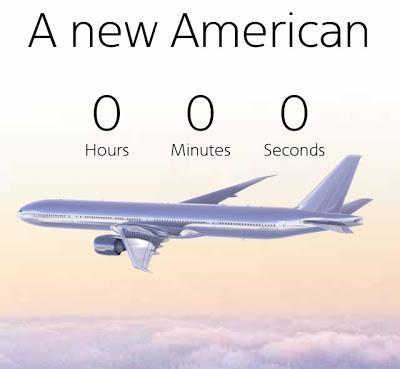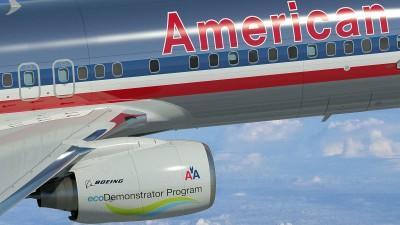
The wait ended with a countdown today on AA.com.
It's official...the iconic polished skin fuselage on American Airlines' jets will soon be a distant memory. AMR management has suggested for months that the "New American" would emerge from bankruptcy looking and feeling like a new airline, but officials with the airline have been tight lipped with regard to what exactly "new" might look like. The vote is still out on the carrier feeling new, but in the near future, a glance out the terminal window will reveal a significantly new look. “We have made a decision to embark on a modernization of our brand,” said Chief Commercial Officer Virasb Vahidi. Here's the result...love it or hate it, may the debate over polished vs. painted skin continue.



American was the last major airline in the United States to bare its aluminum as it ushers out a livery that was introduced in the late 1960's. The concept of polished aluminum skins was adopted even earlier in the airline's history and remained in place due to claimed cost benefits associated with the reduced weight of an unpainted aircraft. But if you happen to be flying around in a freshly painted Cessna 172, don't fret. You probably wouldn't notice any difference in the fuel bill of a painted versus a polished airplane. It's the economies of scale achieved in the operation of an airline where the potential benefits of polished aluminum skin come to light. Aircraft manufacturer Boeing estimates the added weight of the paint on a B777-200 to be roughly 475 lbs. There is an added fuel cost associated with carrying around all that extra weight, and for a company like American Airlines, operating 631 jet aircraft on more than 2,400 flights every day, the added cost is significant. However, Boeing points out that there are other factors like marketing, cost and environmental impact that must be taken into consideration when deciding whether to paint or polish a fleet of aircraft.
Marketing
"Because the colors, patterns, and symbols on the exterior of airplanes convey an image to the public, marketing considerations hold substantial weight in the decision. While some operators believe their image is best presented with a decorative paint scheme, others believe that a polished surface works best. Once established, markings become the most visible identifier of an operator at any airport, and they are often retained for many years." An airliner is like a flying billboard traveling around the world advertising for the airline. The added cost of painting that billboard is just part of the marketing budget.
Cost
Decorative painting is generally included in the base price of a new airplane, but full body paint, unusual markings and late revisions may cost more. So on the front end of the transaction, the old American Airlines livery resulted in a lower purchase price. But that isn't the end of the story. Cost estimates from Boeing indicate that an unpainted aircraft will actually cost more money to maintain over time due to the increased cost of washing, polishing and painting a polished fuselage through its service life.
Maintaining a painted fuselage typically involves repainting every four years, usually during scheduled C or D checks. Instead of completely repainting every time, the operator will alternate between stripping down to bare metal and starting over with completely new paint, versus scuff-sanding the existing paint to apply a fresh new layer. Both are procedures that require a significant investment in equipment, material and personnel.
Maintaining the appearance of a polished airplane requires re-polishing up to three times a year with a special compound applied with mechanical buffers, as well as regular washing to clean oxidation buildup from unpainted surfaces.
Boeing estimates the operating cost associated with maintaining a painted fuselage at $50,000 per year while the annual cost to maintain a polished fuselage is estimated at $132,000.
The Environment
The last part of the equation is the impact on the environment. With advances in biofuels, engine technology and aerodynamic design, the environment has become a line item on the spread sheet and a public relations concern. The choice between painting and polishing must be made after considering any laws that regulate toxic emissions. Painting has the potential to release volatile organic compounds (VOC) and known carcinogenic toxins such as chromium, present in both paint and primer, and cadmium, present only in primer. Since many areas of the world, particularly Europe and the United States, have laws forbidding the emission of these substances, facilities must be equipped with costly equipment and procedures designed to prevent or entrap such emissions.

Polishing an airplane does not involve the potential for chromium and cadmium emission, but it does require the use of solvents. Some solvents do not adversely affect the environment, but others contain ozone-depleting substances and VOCs that are illegal in many parts of the world. Most first-world countries have agreed to the Montreal Protocol that forbids the manufacture of all ozone-depleting substances.
Summary
Though the weight of paint adds to fuel consumption, the fuel-cost savings offered by polished surfaces are often outweighed by the cost of maintaining the polished surfaces. Many operators decide to paint or polish their airplanes based on marketing and environmental impact considerations alone, accepting any added cost as part of doing business. Some believe that a distinctive image can best be achieved with a full paint scheme, while others believe the image can be projected best by mostly polished surfaces. The decision is theirs to make and the benefit is small either way.
Here are a few last looks at current and past liveries of American Airlines.









Click the link below to see American's new Boeing 777-300 being painted.
